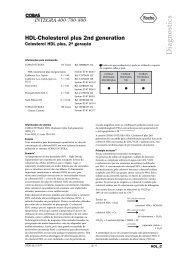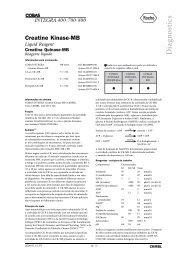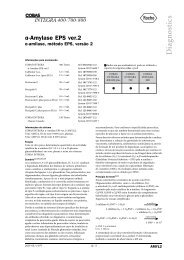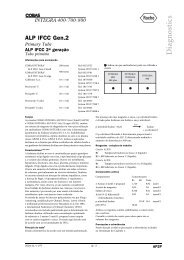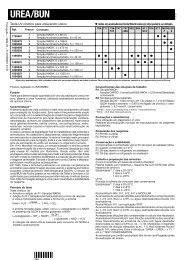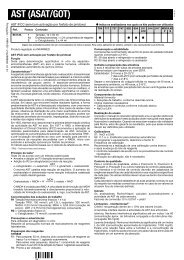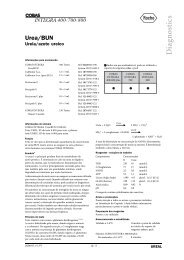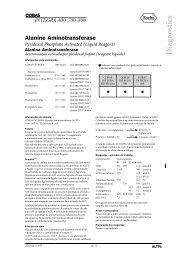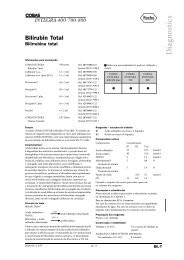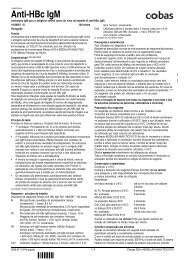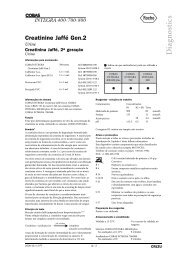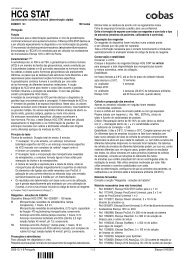LDL-C Plus
LDL-C Plus
LDL-C Plus
Create successful ePaper yourself
Turn your PDF publications into a flip-book with our unique Google optimized e-Paper software.
<strong>LDL</strong>-C <strong>Plus</strong><br />
Specimen collection and preparation<br />
Collect serum using standard sampling tubes.<br />
Li- or Na-heparin plasma.<br />
Stability 11 : 7 days at 2–8°C<br />
30 days at -70°C<br />
Fasting and non-fasting samples can be used. 10 EDTA plasma causes<br />
decreased values.<br />
Centrifuge samples containing precipitate before performing the assay.<br />
Testing procedure<br />
Materials provided<br />
• Working solutions as described above<br />
Additional materials required<br />
• Calibrators and controls as indicated below<br />
• 0.9% NaCl<br />
Assay<br />
Refer to the appropriate operator’s manual and/or the Instrument<br />
Settings section of this insert for analyzer-specific assay instructions.<br />
The performance of applications not validated by Roche is not warranted<br />
and must be defined by the user.<br />
Calibration<br />
Standardization: The method is traceable to the beta quantification<br />
method as defined in the recommendations in the <strong>LDL</strong> Cholesterol<br />
Method Certification Protocol for Manufacturers. 12<br />
S1: 0.9% NaCl<br />
S2: C.f.a.s. (Calibrator for automated systems) HDL/<strong>LDL</strong>-C plus<br />
Calibration frequency<br />
Two point calibration is recommended<br />
• after reagent lot change<br />
• as required following quality control procedures<br />
Calibration verification: Not necessary.<br />
Quality control<br />
For quality control, use Precinorm L, Precipath HDL/<strong>LDL</strong>-C, or other<br />
suitable control material.<br />
The control intervals and limits must be adapted to the individual<br />
laboratory and country-specific requirements. Values obtained<br />
should fall within established limits. Each laboratory should establish<br />
corrective measures to be taken if values fall outside the limits.<br />
Calculation<br />
Roche/Hitachi systems automatically calculate the <strong>LDL</strong>-cholesterol<br />
concentration of each sample.<br />
Conversion factor: mg/dl x 0.0259 = mmol/l<br />
mmol/l x 38.66 = mg/dl<br />
Limitations – interference 11<br />
(US users refer to application sheet for special wash instructions.)<br />
To avoid probe and cuvette carry-over to Tina-quant U Albumin,<br />
Lp(a), Lipase, and Magnesium, use the Evasion software with SMS/<br />
Acid Wash, Multiclean, or NaOH D in the <strong>LDL</strong>-cholesterol assay.<br />
Criterion: Recovery within ± 10% of initial values.<br />
Icterus: No significant interference up to an I index of 60 (approximate<br />
conjugated and unconjugated bilirubin concentration: 60 mg/dl).<br />
Hemolysis: No significant interference up to an H index of 1000<br />
(approximate hemoglobin concentration: 1000 mg/dl).<br />
Lipemia (Intralipid): No significant interference up to an L index of<br />
200. Dilute samples with L index > 200 with 0.9% NaCl (e.g. 1 + 3).<br />
No significant interference from native triglycerides up to 1200 mg/dl.<br />
Dilute samples with triglycerides > 1200 with 0.9% NaCl (e.g. 1 + 3).<br />
Multiply the result by the appropriate dilution factor (e.g. 4).<br />
Rheumatoid factors < 200 IU/ml do not interfere. Ascorbic acid up<br />
to 50 mg/dl and oleic acid up to 4.0 mmol/l do not interfere.<br />
No significant interference from HDL, V<strong>LDL</strong>, or chylomicrons.<br />
In rare cases, elevated immunoglobulin concentrations can lead to<br />
falsely elevated <strong>LDL</strong>-cholesterol results.<br />
Abnormal liver function does affect lipid metabolism; consequently<br />
HDL and <strong>LDL</strong> results are of limited diagnostic value. In some patients<br />
with abnormal liver function, the <strong>LDL</strong>-C plus result is significantly<br />
negatively biased versus beta quantification results.<br />
Measuring/reportable range<br />
3–550 mg/dl (0.03–5.5 g/l or 0.077–14.2 mmol/l)<br />
Determine samples with <strong>LDL</strong>-cholesterol concentrations > 550 mg/dl<br />
via the rerun function. On instruments without rerun function, manually<br />
dilute samples with 0.9% NaCl (e.g. 1 + 1). Multiply the result by the<br />
appropriate dilution factor (e.g. 2).<br />
2147068001 02 01<br />
Expected values8,13 Levels in terms of risk for coronary heart disease:<br />
Adult levels:<br />
Recommended (desirable) < 130 mg/dl (



